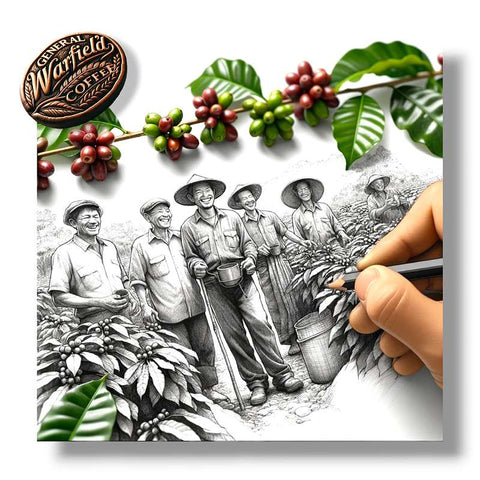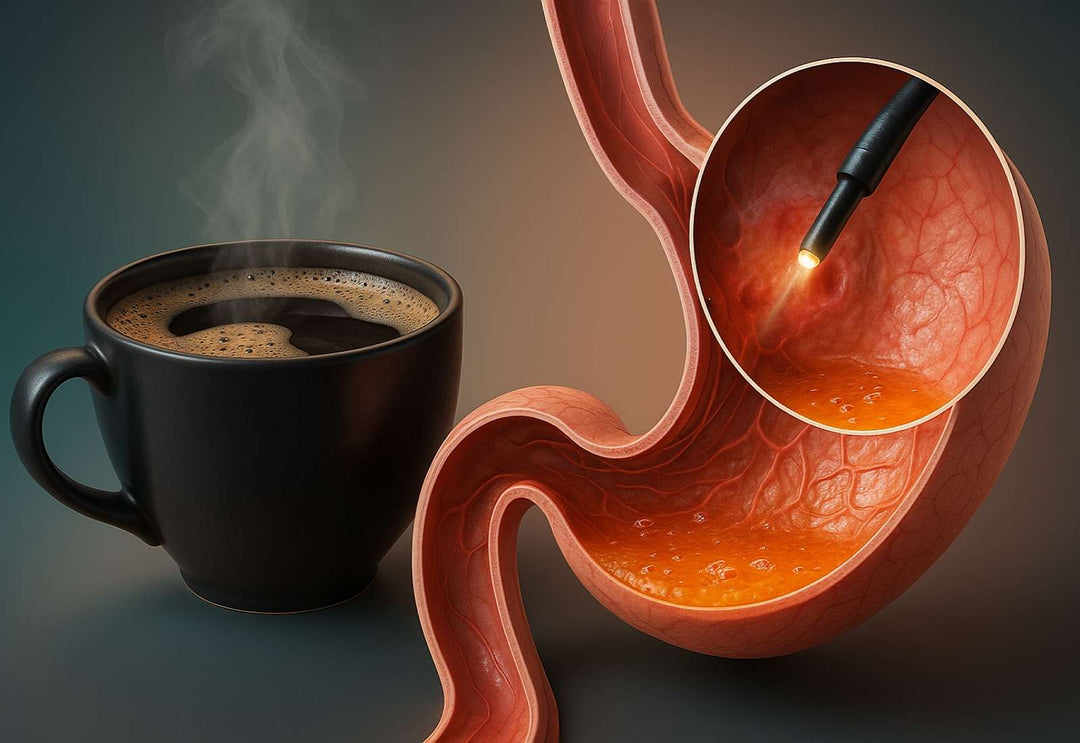Ultimate Guide to Ethiopian Coffee
Introduction

Coffee lovers around the world can't get enough of Ethiopian coffee. With its rich history and unparalleled flavor profiles, this beloved beverage has cemented its place as one of the finest in the world. In this ultimate guide, we'll take you on a journey through the vibrant coffee culture of Ethiopia, revealing everything you need to know to brew a perfect cup of this cherished drink.
From the high-altitude regions where the coffee plants thrive to the meticulous harvesting and processing methods, we'll explore the factors that make Ethiopian coffee truly special. Discover the unique taste characteristics of the different coffee regions, from the fruity and floral flavors of Sidamo to the bold and full-bodied profiles of Harrar and Yirgacheffe.
Join us as we delve into the art of roasting and grinding the beans, uncovering the secrets to achieving the optimal flavor and aroma. Whether you're a seasoned coffee connoisseur or a home brewing enthusiast, this comprehensive guide will equip you with the knowledge and techniques to elevate your coffee experience to new heights.
Get ready to embark on an adventure through the world of Ethiopian coffee, where tradition meets innovation, and the perfect cup awaits.
What is the History of Ethiopian Coffee?
Ethiopia is widely regarded as the birthplace of coffee. Legend has it that a goat herder named Kaldi discovered the energizing effects of coffee beans after noticing his goats becoming lively and energetic after consuming them. This serendipitous discovery led to the cultivation and widespread consumption of coffee in Ethiopia.
Coffee has been an integral part of Ethiopian culture for centuries. Ethiopians have a deep appreciation for coffee, and it plays a significant role in social and cultural gatherings. Traditional coffee ceremonies are a cornerstone of Ethiopian hospitality, where the aroma of freshly brewed coffee fills the air, and friends and family gather to partake in the communal experience.
Ethiopian Coffee Regions and their Unique Flavors

Ethiopia is home to several distinct coffee-growing regions, each with its own unique flavor profiles. The country's diverse geography, ranging from high-altitude plateaus to lush rainforests, contributes to the varied taste characteristics of Ethiopian coffee.
One of the most renowned coffee regions in Ethiopia is Sidamo, located in the southern part of the country. Sidamo coffee is known for its fruity and floral flavors, with hints of citrus, berry, and jasmine. The high altitudes and fertile soil of the region create the ideal conditions for growing these exceptional beans.
Another notable coffee region in Ethiopia is Harrar, located in the eastern part of the country. Harrar coffee is distinctively bold and full-bodied, with a wine-like acidity and complex flavor notes of blueberry, chocolate, and spice. The unique dry processing method used in Harrar contributes to its characteristic flavor profile.
Yirgacheffe, situated in the Sidamo region, is also famous for its high-quality coffee. Yirgacheffe coffee is known for its delicate and tea-like characteristics, with flavors of lemon, bergamot, and floral undertones. The region's elevation and unique microclimate contribute to the exceptional quality of Yirgacheffe coffee.
What are the Most Popular Ethiopian Coffee Varieties?
Ethiopia is home to numerous coffee varieties, each with its own distinct characteristics. Some of the most popular Ethiopian coffee varieties include:
1. Ethiopian Heirloom: This is a term used to describe the indigenous coffee varieties grown in Ethiopia. Ethiopian Heirloom coffee is known for its exceptional flavor complexity and diversity. It encompasses a wide range of flavor profiles, making it highly sought after by coffee enthusiasts.
2. Ethiopian Yirgacheffe: As mentioned earlier, Yirgacheffe coffee is renowned for its delicate and tea-like flavors. It is often considered one of the highest-quality coffee varieties in Ethiopia, with its distinct acidity and floral notes.
3. Ethiopian Sidamo: Sidamo coffee is highly regarded for its fruity and floral flavors, with a bright acidity that adds vibrancy to the cup. It is a versatile coffee variety that can be enjoyed in both single-origin and blended coffees.
4. Ethiopian Harrar: Harrar coffee, with its bold and full-bodied profile, is a favorite among those who prefer a more robust coffee experience. Its complex flavor notes and unique dry processing method make it a standout variety in the Ethiopian coffee scene.
How to Choose and Store Ethiopian Coffee Beans
Selecting and storing coffee beans correctly is crucial to preserving their freshness and flavor. When choosing Ethiopian coffee beans, look for those that have been recently roasted to ensure optimal flavor. Look for beans with a shiny appearance, indicating their freshness.
To store Ethiopian coffee beans, it is best to keep them in an airtight container away from light, heat, and moisture. The container should be kept in a cool, dry place, such as a pantry or cupboard. Avoid storing coffee beans in the refrigerator or freezer, as the moisture and temperature fluctuations can compromise the flavor.
The Art of Brewing Ethiopian Coffee

Brewing Ethiopian coffee is an art form that requires precision and attention to detail. Here are the steps to brewing the perfect cup of Ethiopian coffee:
1. Grind the beans: Start by grinding your Ethiopian coffee beans to the desired coarseness. For traditional Ethiopian coffee brewing methods, a medium-coarse grind is recommended.
2. Measure the coffee and water: Use a scale to measure the appropriate ratio of coffee to water. A general guideline is to use 1 tablespoon of coffee for every 6 ounces of water.
3. Preheat the equipment: Preheat your brewing equipment, whether it's a French press, pour-over dripper, or espresso machine. This helps maintain the optimal brewing temperature and ensures even extraction.
4. Bloom the coffee: In Ethiopian coffee brewing, blooming refers to the process of pre-infusing the coffee grounds with a small amount of hot water. This helps release the trapped gases and enhances the flavor extraction.
5. Pour the water: Slowly pour the remaining hot water over the coffee grounds, making sure to saturate them evenly. Use a circular motion to ensure even extraction and avoid over-extraction or under-extraction.
6. Steep or brew: Depending on the brewing method, allow the coffee to steep or brew for the recommended time. This can vary from a few minutes for a French press to several seconds for an espresso shot.
7. Serve and enjoy: Once the coffee has brewed, pour it into your favorite mug or cup and savor the rich flavors and aromas of Ethiopian coffee. Add any desired sweeteners or milk to enhance the taste, or enjoy it black to experience the true essence of the coffee.
Traditional Ethiopian Coffee Ceremonies
Ethiopian coffee ceremonies are an integral part of Ethiopian culture and a symbol of hospitality and community. These elaborate ceremonies involve roasting, grinding, and brewing coffee in a traditional clay pot called a jebena, accompanied by the burning of incense and the serving of popcorn or roasted barley.
The host of the coffee ceremony meticulously roasts the green coffee beans over an open flame, stirring them in a pan until they turn dark and aromatic. Once the beans are roasted, they are ground using a mortar and pestle, producing a fine powder.
The ground coffee is then brewed in the jebena, which is often decorated with intricate patterns and designs. The coffee is brewed slowly over hot coals, creating a rich and flavorful beverage. The host pours the coffee from a height into small cups, a tradition known as the Ethiopian coffee pour, which is believed to enhance the flavors and aromas.
Ethiopian Coffee Recipes and Beverages
Ethiopian coffee is not only enjoyed as a hot beverage but also used to create a variety of delicious recipes and beverages. Here are a few popular Ethiopian coffee-inspired creations:
1. Ethiopian Coffee Martini: This cocktail combines the flavors of Ethiopian coffee with vodka, Kahlua, and a touch of chocolate liqueur. Garnish with a coffee bean for an extra touch of elegance.
2. Ethiopian Coffee Ice Cream: Indulge in the creamy richness of homemade coffee ice cream infused with the bold flavors of Ethiopian coffee. Serve it in a waffle cone or alongside a warm slice of chocolate cake.
3. Ethiopian Coffee Rubbed Steak: Elevate your grilling game by using a coffee rub made with Ethiopian coffee, spices, and herbs. The robust flavors of the coffee add depth and complexity to the steak.
4. Ethiopian Coffee Chocolate Truffles: These decadent treats combine the flavors of dark chocolate and Ethiopian coffee. Roll the truffles in cocoa powder for an extra burst of flavor.
Sustainable & Fair Trade Practices in the Ethiopian Coffee Industry

Ethiopia is committed to sustainable and fair trade practices in its coffee industry. The country has implemented various initiatives to ensure that coffee farmers receive fair wages and that the cultivation and production processes are environmentally friendly.
Organizations such as Fairtrade International and the Rainforest Alliance work closely with Ethiopian coffee farmers to promote sustainable farming practices, protect biodiversity, and improve the livelihoods of coffee-growing communities. These initiatives help ensure that Ethiopian coffee continues to be produced ethically and sustainably.
By purchasing coffee certified by these organizations, consumers can support the sustainable development of the Ethiopian coffee industry while enjoying a cup of coffee that is not only delicious but also socially and environmentally responsible.
Conclusion: Enjoying the Perfect Cup of Ethiopian Coffee

Ethiopian coffee is a true delight for coffee enthusiasts around the world. From its rich history and vibrant coffee culture to its unique flavor profiles and brewing methods, Ethiopian coffee offers a truly exceptional coffee experience.
By exploring the different coffee regions, learning about the popular varieties, and understanding the art of brewing, you can unlock the full potential of Ethiopian coffee and brew a perfect cup every time. Whether you prefer the fruity and floral flavors of Sidamo or the bold and full-bodied profile of Harrar, Ethiopian coffee has something to offer every coffee lover.
So, grab your favorite Ethiopian coffee beans, follow the brewing techniques, and embark on a journey through the flavors and aromas of Ethiopia. Elevate your coffee experience and savor the magic of Ethiopian coffee, where tradition meets innovation and the perfect cup awaits. Cheers!
General Warfield's Specialty Grade Ethiopian Roast is Now Available! Experience the Pinnacle of Your Coffee Journey and Order Yours Today! Click Image Below to Experience True Love in a Cup.
Click here to see our other roasts.




Leave a comment